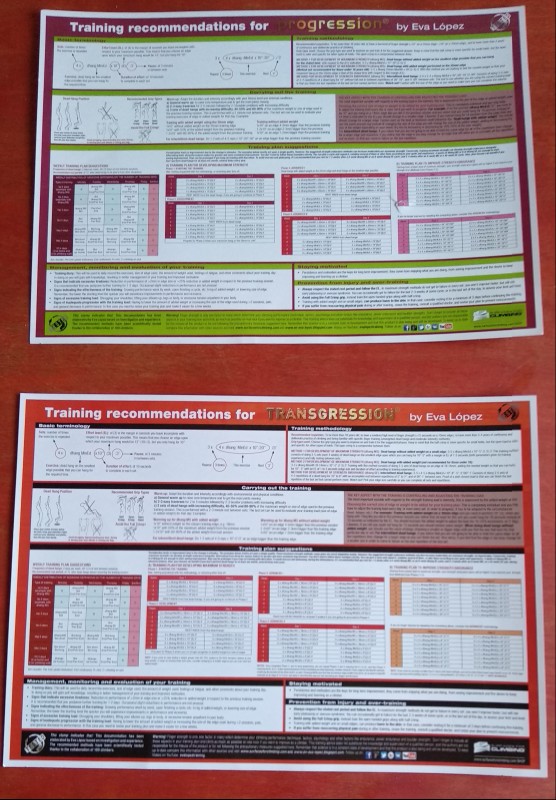Versión en español
As promised, here you have the first entry in this new intermittent dead hangs series. It will serve as an introduction before delving into my research. Even though my last work was presented at the 3rd Rock Climbing Research Congress in 2016 (Telluride, USA), all the experimental work this and other research (a total of 6 different studies) is based on was performed in 2004 and 2010, and compiled into my 2014 thesis. A long time has passed since, so an in-depth discussion of the topic was long due. My apologies for not having done this earlier. We’ll start with some clarifications:
a) why this name instead of “repeaters”, the most used name in the English-speaking world, and
b) why put forward this method and compare its effects on strength and endurance with those obtained through maximum strength dead-hangs, both weighted and unweighted.
By answering these you will not only learn why the research works and the training programs are designed the way they are, but perhaps you’ll also enjoy the process of understanding and even performing them. There’s nothing better than choosing a program and tailoring or discarding it based on your knowledge of how it works, which in turn allows you to predict what effects will it have on you or your trainees according to your respective goals.
"What, why, when, how, where and who are questions that are continually asked in medicine. Knowing the answers to them is not always easy or even possible. Understanding them can be even more difficult. Attempting to know and understand the answers, however, is the goal of allied health professionals. Knowing and understanding these whats, whys, whens, hows, wheres, and whos of allied health define the differences between technicians and professionals." (Houglum, Peggy A., 2005. Therapeutic Exercise for MusculoSkeletal Injuries, 2nd Edition. Human Kinetics)
 |
Mie Kastet trying hard in Misje, Hordaland (Norway). Photo: Jon Solberg Høyland (Thanks Mie and Jon for the pic!)
|
Why call them Intermittent Dead Hangs instead of ‘Repeaters’?
In truth, when I started the experimental design of my studies I did not know this really descriptive English term: ‘Repeaters’. A bit of research shows that, as far as I have been able to go back in time, the first author to put this term on paper was none other than the great pioneer Eric Hörst in his 1997 “How to climb 5.12”.
Initially I wasn’t aware of that terminology and of other proposals regarding different work/rest ratios and number of sets; then I started learning more about the most popular ones (that from Eric Hörst and, mainly, from the Anderson Brothers) but decided against changing the term. The reason is that the scientific literature has been referring to this as “Isometric intermittent contractions” (Bigland-Ritchie et al., 1981; Bellemare & Grassino, 1982; Sjøgaard et al., 1988), for some time now, as well as using the expression “Intermittent training” (Green, 1979; Simoneau et al., 1985).
Scientists tend to adopt the terminology that is already established in their new research; which is a good thing, because it allows professionals in similar lines of research to readily understand concepts, and to adapt them to their sport of interest, enriching the field for everyone. This is what I’ve tried to do; this way scientists around the world, no matter if they climb or not, can identify the physiological base and its effects, its relevance for each sport and, most importantly, start conversations knowing they are on the same page
Why train Intermittent Dead Hangs? Why compare their effects with Maximum Strength Dead Hangs?
These are questions that you will be able to answer based on solid criteria when you finish reading this series, but let’s advance some concepts.
1. Intermittent Dead Hangs and Finger Endurance Development
Climbing is not just about the high finger power levels that allow us to grab tiny holds, to climb on very small footholds or to go footless; having an enhanced ability for recovery is also key (Philippe et al., 2012; McLeod et al., 2007). Our fingers’ flexor muscles need to sustain the repetitive effort of high-intensity intermittent isometric contractions: the gripping and releasing of handholds. This is more relevant in the hardest sections of a route, those that determine its grade and also our performance.
 |
| Climbing requires the ability to apply high levels of force on small holds, as Mina Leslie-Wujastyk shows (thanks for the picture to Mina & David!). Source: Mina’s Facebook page. Picture by: David Mason |
Depending on what percentage of our maximum voluntary contraction (MVC) we apply on a hold there will be, among other effects, a varying level of blood flow occlusion, and fatigue will appear at different rates. We can infer that, by increasing our maximum strength, we will be able to grab for 15-20 seconds a hold we previously would not have been able to hold for 8 seconds. Hence we could say, and it has been experimentally shown (López-Rivera & González-Badillo, 2012), that training maximum strength develops in parallel the ability to sustain high-intensity efforts, like gripping one tiny hold after another.
This said, wouldn’t it also make sense to specifically work our ability for recovering between contractions through intermittent dead-hangs? In fact, this ability is, along with finger strength, another key performance factor (Ferguson & Brown, 1997, Fryer et al., 2014, MacLeod et al., 2007; Philippe et al. 2012). In particular, the investigation group C-HIPPER led by Vanesa España-Romero have recently (and very timely for me) shown that the forearm oxidative capacity index is a predictor of climbing performance (Fryer et al., 2016). This ability would be developed mostly when releasing the hold, especially for more than 3 seconds. Regarding sport climbing, I have observed in the field that there’s opportunity for this while clipping (3-5 seconds) and when shaking at a rest (3 to 10 seconds depending on the climber’s characteristics and how good the rest point is).
The method I proposed was 3-5 x 4-5 x dead-hang x10” :5”/1’, that reads like this:
3 to 5 sets of 4 to 5 ten-second dead-hang repetitions; the rest is 5 seconds between repetitions and 1 minute between sets. In my works I chose the open crimp as grip type, and the edge as the type of hold. The size of the edge was such that, as I advanced in the previous entry, allowed to complete all the volume reaching failure in the last repetition of the last set. To accomplish that the participants had to continually choose the right edge size for each set or even repetition so they would build up fatigue but not too soon. The eight-week program looked like this:
week 1: 3 sets, 4 reps each; week 2: 4 sets, 4 reps each; week 3: 5 sets; week 4: 5 sets; week 5: 3 sets, 5 reps each; week 6: 4 sets, 5 reps each, week 7: 5 sets; week 8 : 5 sets.
IMPORTANT NOTES
It is essential to be aware that these workouts were performed twice a week with 48 h rest between them, and they did not replace the actual climbing contents. The participants in the study were sport climbers (sentence added on 11 August). The dead hangs were done at the start of the session and there was a 15’ rest before proceeding to the next workout (climbing on the wall or others). The rest of the training contents, including the climbing part of the session, meaning, the complete training plan itself (these last five words were added on 11 August) was controlled and standardized for all participants.
Another aspect I’d like to stress is that the fact that I selected this configuration: type of grip (these last three words were added on 11 August) and a particular work/rest ratio and number of sets and repetitions for research purposes, and that I observed certain effects using them, does not mean that I propose to take those numbers and repeat them time and again regardless of a person’s level. Ideally you would make changes periodically, and switch back and forth to other methods during your long-term plan. But we are getting ahead of ourselves.
1.1. What’s the rationale behind those 10” reps and 5”/1’ rests?
1.1. What’s the rationale behind those 10” reps and 5”/1’ rests?
Mimicking the activity-to-rest ratio of a sport has been suggested (Meckel et col., 2009) as a way of improving specific endurance. At the time of the experimental design I thought that for sport climbing we could then do a high-intensity intermittent dead-hangs method with 8-10” repetitions (White & Olsen, 2010), managing fatigue by changing the hold depth. This is similar to cluster training with “inter-repetition” rests put forward by authors like Iglesias et col. (2010), Haff et col. (2008), Hansen (2012) or more recently, Nicholson et al. (2016).
This specific finger training could promote faster phosphocreatine resynthesis (Tomlin & Wenger, 2001; McMahon & Jenkins, 2002) and would presumably enhance oxygenation during short rest periods. Both adaptations would lead to higher performance by allowing to sustain high levels of isometric force.
If Fryer et al. (2016) are right when they suggest that this capacity for oxygenation between contractions is a performance predictor, the next question would be if developing this capacity -with the method I propose or others- would result in elevated sport level. It is reasonable to think that this would be the case…
 |
In this respect, McGee et col. (1992) and Robinson et col. (1995) have shown that the most effective method to make high-intensity endurance go up is to use high loads and do as many sets as possible while maintaining said load. And this sustained load is why my method does not entail lots of sets and repetitions as other, more extensive ones, like the Beastmaker fingerboard training plan by Ned Feehally or the Anderson Brothers’ RPTC repeater Training Protocol. Another difference is that this method never aims to replace a real climbing session at the gym or the crag, that will obviously be much longer and work other important qualities like power-endurance, bouldering (these last two words were added on 10 August) or ARC. Therefore, the intermittent dead-hangs are only a part of the session. The above programs, that are higher in total volume and use a variety of hold types, may be beneficial to those who can’t go to a climbing gym or a climbing spot, and perhaps they are designed with this kind of user in mind, which makes perfect sense from my point of view.
Regarding the rest-interval between repetitions, it was 5-second long to account for these factors:
- during a hard section the hand takes 1 to 5 seconds in average to go from one hold to the next; clipping takes around 3 seconds and shaking the forearms 2-5 seconds.
- five seconds is the duration of the oxygenation mechanism between isometric intermittent contractions according to Demura et col. (2008), or three seconds as Fryer et al. (2014) suggest for higher sport levels (this could be the next step after having trained with 5-second pauses).
- this is the time that a person needs to chalk up and accommodate the fingers to the smaller holds in higher level athletes.
Lastly, the 1 minute rest between sets was in line with the conclusions in Watts et col. (2008): it does not allow to fully recover maximum strength and is thus adequate for working strength-endurance.
2. Intermittent Dead Hangs and Increased Maximum Strength
As has already been said, finger maximum strength is a key performance factor in climbing (Balas et al., 2012; MacLeod et al., 2007; Philippe et al., 2012), so it is reasonable to keep it in sight for our training sessions. We know that the improvement in maximum strength is caused by two kinds of mechanisms:
a) Neural adaptations: recruitment, firing rate, intermuscular coordination, motor unit synchronization, and
b) Structural changes: hypertrophy, muscle fiber type switch, capillarization, metabolic gains.
Before explaining each of these aspects and their relationship with the kinds of loads we can use and how long to use them, we should be aware that in the human body almost no phenomenon happens in a vacuum; more likely they overlap, one of them taking priority regardless of the combination of volume, pause intervals, training experience, level, etc. This is why we should take what follows as general information and not as rules set in stone.
2.1. Strength gains due to Neural Factors
We know that this first group of changes is associated to the early improvement after any strength program, but they are more noticeable in methods that:
- Use high loads: those over 80% MVC in trained subjects (Hakkinen et al., 2001), and over 70% in untrained ones (Peterson, Rhea & Alvar, 2004); this implies low repetitions (1 to 8 RM) or shorter (up to 15”) isometric contractions.
- Use long rest intervals between sets (3-5 minutes) to allow for a complete recovery.
 |
| Maja Vidmar. Photo: Javipec |
2.2. Strength Gains due to Structural Changes
As for the second group of changes, hypertrophy is a relevant one. This does not necessarily mean that you will be able to notice a significant increase in the volume or perimeter of your forearms. The changes can be so subtle that they need to be measured with DXA (Dual-energy X-ray absorptiometry), CT (Computerized Tomography) or MRI (Magnetic Resonance Imaging) (Colyer et al., 2016). This may be why some studies have not detected this effect (Sveen et al., 2016). The changes are statistically significant in most subjects after around 6 weeks, and are more noticeable if i) the training volume is moderately high: 8 to 15 RM/set or equivalent time for isometric methods, ii) the intensity is also moderately high: 75% of 1RM (65% for untrained persons), and most importantly iii) the recovery between sets is short, about 1 minute (Goto et al., 2005; Miranda et al., 2009; Nicholson et al., 2016; Schoenfeld, 2010; Willardson, 2006). The authors agree that the key is to promote a mechanical loading for long enough, thanks to the combination of a high absolute load, the number of repetitions and the incomplete pause.
Now, could the intermittent dead-hangs tick all the boxes? Would it be reasonable to say that they can promote strength via a hypertrophy effect? We’ll see…
Well, after this “short introduction” and hoping it has been useful to begin understanding -and liking- this particular method, in the next entry I will present an extended version of the paper that I took to last summer’s US congress, titled: "Comparison of the Effects of Three Hangboard Training Programs on Maximal Finger Strength in Rock Climbers". We will begin by checking if this intermittent method is useful for improving not only endurance, but also finger strength, and in that case how should it be applied.
See you soon!
Clic to enlarge
REFERENCES
- Anderson, Michael, L.; Anderson, Mark L. (2014). The Rock Climber's Training Manual: A guide to continuous improvement. Fixed Pin Public
- Baláš, J., Pecha, O., Martin, A.J.; Cochrane, D. (2012). Hand–arm strength and endurance as predictors of climbing performance. European Journal of Sport Science , 12 (1), 16-25.
- Bellemare, F., Grassino, A. (1982). Effect of pressure and timing of contraction on human diaphragm fatigue. Journal of Applied Physiology (Bethesda, Md. : 1985), 53(5), 1190–1195.
- Bigland-Ritchie, B, Bellemare, F.; Woods, JJ. (1981). Central and peripheral fatigue in intermittent submaximal contractions. in: Porter R, Whelan J (Eds.) Human muscle fatigue: physiological mechanisms. Ciba Foundation Symposium No. 82. Pitman Medical, London.
- Bigland-Ritchie, B. (1984). Change in muscle contractile properties and neural control during human muscular fatigue. Muscle & Nerve, 7, 691–699.
- Colyer, S. L., Roberts, S. P., Robinson, J. B., Thompson, D., Stokes, K. A., Bilzon, J. L.,; Salo, A. I. (2016). Detecting meaningful body composition changes in athletes using dual-energy x-ray absorptiometry. Physiological measurement, 37(4), 596.
- Demura, S., Nakada, M., Yamaji, S., Nagasawa, Y. (2008). Relationships between ForceTime Parameters and Muscle Oxygenation Kinetics during Maximal Sustained Isometric Grip and Maximal Repeated Rhythmic Grip with Different Contraction Frequencies. Journal of Physiological Anthropology, 27(3):161-168
- Ferguson, R. A., Brown, M. D. (1997). Arterial blood pressure and forearm vascular conductance responses to sustained and rhythmic isometric exercise and arterial occlusion in trained rock climbers and untrained sedentary subjects. European Journal of Applied Physiology and Occupational Physiology, 76(2), 174–180.
- Fryer, S., Stoner, L., Lucero, A., Witter, T., Scarrott, C., Dickson, T., … Draper, N. (2014). Haemodynamic Kinetics and Intermittent Finger Flexor Performance in Rock Climbers. International Journal of Sports Medicine, 36(2), 137–142.
- Fryer, S., Stoner, L., Stone, K., Giles, D., Sveen, J., Garrido, I.,; España-Romero, V. (2016). Forearm muscle oxidative capacity index predicts sport rock-climbing performance. European Journal of Applied Physiology, 116(8), 1479–1484.
- Goto K, Ishii T, Kizuka N, Takamatsu K (2005). The impact of meta- bolic stress on hormonal responses and muscular adaptations. Med Sci Sport Exer 37:955–963.
- Green, H. J. (1979). Metabolic aspects of intermittent work with specific regard to ice hockey. Canadian journal of applied sport sciences. Journal canadien des sciences appliquees au sport, 4(1), 29-34.
- Haff, G.G., Hobbs, R.T., Haff, E.E., Sands, W.A., Pierce, K.C. y Stone, M.H. (2008). Cluster training: a novel method for introducing training program variation. Strength & Conditioning Journal, 30(1), 67-76.
- Hakkinen, K., Pakarinen, A., Kraemer, W.J., Hakkinen, A., Valkeinen, H. y Alen, M. (2001). Selective muscle hypertrophy, changes in EMG and force, and serum hormones during strength training in older women. Journal of Applied Physiology 91(2):569-80
- Hansen, K. T., Cronin, J. B., Pickering, S. L.; Newton, M. J. (2011). Does cluster loading enhance lower body power development in preseason preparation of elite rugby union players?. The Journal of Strength and Conditioning Research, 25(8), 2118-2126
- Hörst, E. (1997). How to Climb 5.12!. FalconGuides.
- Iglesias E., Boullosa D.A., Dopico X., Carballeira E. (2010) Analysis of factors that influence the maximum number of repetitions in two upper-body resistance exercises: curl biceps and bench press. J Strength Cond Res. 24(6):1566-72
- MacLeod, D., Sutherland, D. L., Buntin, L., Whitaker, A., Aitchison, T. C., Watt, I., … Grant, S. (2007). Physiological determinants of climbing-specific finger endurance and sport rock climbing performance. Journal of Sports Sciences, 25(12), 1433–1443.
- McGee, D., Jessee, T. C., Stone, M. H.; Blessing, D. (1992). Leg and hip endurance adaptations to three weight-training programs. The Journal of Strength and Conditioning Research, 6(2), 92-95
- McMahon, S. y Jenkins, D. (2002). Factors affecting the rate of phosphocreatine resynthesis following intense exercise. Sports Medicine, 32(12), 761-784.
- Meckel, Y., Machnai, O.; Eliakim, A. (2009). Relationship among repeated sprint tests, aerobic fitness, and anaerobic fitness in elite adolescent soccer players. The Journal of Strength & Conditioning Research, 23(1), 163-169.
- Miranda, H., Simão, R., Moreira, L. M., Souza, R., Souza, J. A. A. A., Salles, B. F.,; Willardson, J. (2009). Effect of rest interval length on the volume completed during upper body resistance exercise. Journal of Sports Science and Medicine, 8, 388-392
- Nicholson, G., Ispoglou, T.,; Bissas, A. (2016). The impact of repetition mechanics on the adaptations resulting from strength-, hypertrophy- and cluster-type resistance training. European Journal of Applied Physiology, 116(10), 1875–1888.
- Ogborn, D., Schoenfeld, B. J. (2014). The Role of Fiber Types in Muscle Hypertrophy: Implications for Loading Strategies. Strength and Conditioning Journal, 36(2), 20–25.
- Peterson, M.D., Rhea, M.R.; Alvar, B.A. (2004). Maximizing strength development in athletes: a meta-analysis to determine the dose-response relationship. The Journal of Strength and Conditioning Research, 18(2), 377-382
- Philippe, M., Wegst, D., Müller, T., Raschner, C.,; Burtscher, M. (2012). Climbing-specific finger flexor performance and forearm muscle oxygenation in elite male and female sport climbers. European Journal of Applied Physiology, 112(8), 2839–2847.
- Robinson, J.M., Stone, M.H., Johnson, R.L., Penland, C.M., Warren, B.J.; Lewis, R.D. (1995). Effect of different weight training exercise/rest intervals on strength, power, and high intensity exercise endurance. The Journal of Strength and Conditioning Research 9:216-221.
- Simoneau, J. A., Lortie, G., Boulay, M. R., Marcotte, M., Thibault, M. C.,; Bouchard, C. (1985). Human skeletal muscle fiber type alteration with high-intensity intermittent training. European journal of applied physiology and occupational physiology, 54(3), 250-253.
- Schoenfeld, B. J. (2010). The mechanisms of muscle hypertrophy and their application to resistance training. Journal of Strength & Conditioning Research, The, 24(10), 2857–2872.
- Sjøgaard, G., Savard, G., & Juel, C. (1988). Muscle blood flow during isometric activity and its relation to muscle fatigue. European Journal of Applied Physiology and Occupational Physiology, 57(3), 327–335.
- Sveen, J., Stone, K. J., ; Fryer, S. M. (2016). Strength and forearm volume differences in boulderers and sport climbers.
- Tomlin, D.L. y Wenger, H.A. (2001). The relationship between aerobic fitness and recovery from high intensity intermittent exercise. Sports Medicine, 31(1), 1-11.
- Willardson, J.M. (2007). The application of training to failure in periodized multiple-set resistance exercise programs resistance exercise programs. The Journal of Strength & Conditioning Research, 21(2):628-631.
- Watts, P. (2004). Physiology of difficult rock climbing. European Journal of Applied Physiology (91), 361-372
- White, D.J., y Olsen, P.D. (2010). A time motion analysis of bouldering style competitive rock climbing. The Journal of Strength & Conditioning Research, 24(5), 1356-1360.







 https://orcid.org/0000-0003-0304-5290
https://orcid.org/0000-0003-0304-5290







